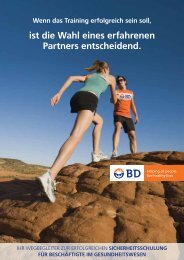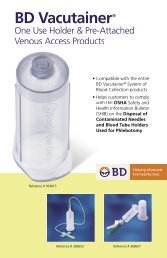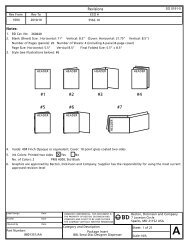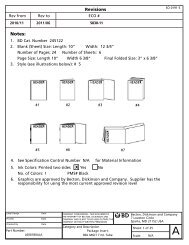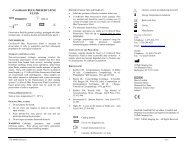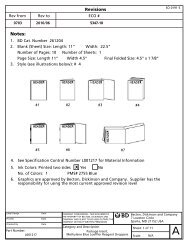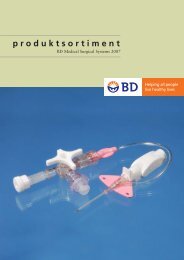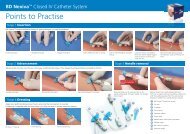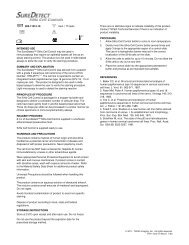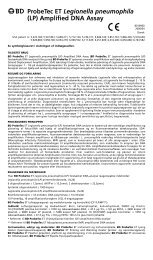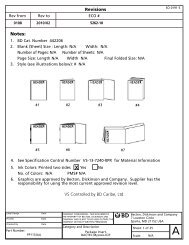base pdf dicto.indd - BD
base pdf dicto.indd - BD
base pdf dicto.indd - BD
Create successful ePaper yourself
Turn your PDF publications into a flip-book with our unique Google optimized e-Paper software.
Buffered Peptone Water<br />
Buffered Peptone Casein Water<br />
Intended Use<br />
Buffered Peptone Water and Buffered Peptone Casein Water<br />
are used for preenriching injured Salmonella species from food<br />
specimens to increase recovery.<br />
Summary and Explanation<br />
Edel and Kampelmacher 1 noted that food preservation techniques<br />
involving heat, desiccation, preservatives, high osmotic<br />
pressure or pH changes cause sublethal injury to salmonellae.<br />
Preenrichment in a nonselective medium allows for repair of cell<br />
damage and facilitates the recovery of salmonellae. Lactose Broth<br />
is frequently used for this purpose but it may be detrimental to<br />
recovering salmonellae. 2 Buffered Peptone Water maintains a<br />
high pH over the preenrichment period and results in repair of<br />
injured cells that may be sensitive to low pH. 3 This is particularly<br />
important for vegetable specimens which have a low buffering<br />
capacity. Buffered Peptone Water can be used for testing dry<br />
poultry feed. 4 Test methods have been published for a variety<br />
of food samples. 5,6 Casein peptone in Buffered Peptone Casein<br />
Water conforms with ISO 6579:2002. 7<br />
User Quality Control<br />
NOTE: Differences in the Identity Specifications and Cultural Response testing for media offered as both Difco and BBL brands may reflect differences in the<br />
development and testing of media for industrial and clinical applications, per the referenced publications.<br />
Identity Specifications<br />
Difco Buffered Peptone Water or Difco Buffered<br />
Peptone Casein Water<br />
Dehydrated Appearance: Cream-white to light biege, free flowing, homogeneous,<br />
free of extraneous material.<br />
Solution:<br />
2.0% solution, soluble in purified water. Solution<br />
is light amber, clear to slightly hazy.<br />
Prepared Appearance: Light amber, clear.<br />
Reaction of 2.0%<br />
Solution at 25°C:<br />
pH 7.2 ± 0.2 (Peptone Water)<br />
pH 7.0 ± 0.2 (Casein Water)<br />
Cultural Response<br />
Difco Buffered Peptone Water or Difco Buffered<br />
Peptone Casein Water<br />
Prepare the medium per label directions. Inoculate and incubate at<br />
35 ± 2°C for 18-24 hours.<br />
INOCULUM RECOVERY RECOVERY<br />
ORGANISM ATCC CFU PEPTONE WATER CASEIN WATER<br />
Salmonella enterica<br />
subsp. enterica<br />
serotype Enteritidis 13076 10-100 Good Good<br />
Salmonella enterica<br />
subsp. enterica<br />
serotype Typhimurium 14028 10-100 Good Good<br />
Salmonella enterica<br />
subsp. enterica<br />
serotype Typhi 19430 10-100 Good Good<br />
Salmonella panama<br />
ALM 41 10-100 N/A Good<br />
Identity Specifications<br />
BBL Buffered Peptone Water<br />
Dehydrated Appearance: Cream-white to light tan, free flowing, homogeneous,<br />
free of extraneous material.<br />
Solution:<br />
2.0% solution, soluble in purified water. Solution<br />
is light yellow to tan or amber, clear to slightly<br />
hazy.<br />
Prepared Appearance: Light yellow to tan or amber, clear to slightly<br />
hazy.<br />
Reaction of 2.0%<br />
Solution at 25°C: pH 7.2 ± 0.2<br />
Cultural Response<br />
BBL Buffered Peptone Water<br />
Prepare the medium per label directions. Inoculate and incubate at<br />
35 ± 2°C for 18-24 hours.<br />
ORGANISM ATCC INOCULUM CFU RECOVERY<br />
Escherichia coli 25922 10-10 3 Good<br />
Salmonella enterica<br />
subsp. enterica<br />
serotype Enteritidis 13076 10-10 3 Good<br />
Salmonella enterica<br />
subsp. enterica<br />
serotype Typhimurium 14028 10-10 3 Good<br />
Salmonella enterica<br />
subsp. enterica<br />
serotype Typhi 19430 10-10 3 Good<br />
Difco & BBL Manual, 2nd Edition
Principles of the Procedure<br />
These preenrichment media contain peptone as a source of carbon,<br />
nitrogen, vitamins and minerals. Sodium chloride maintains the<br />
osmotic balance. Phosphates buffer the media.<br />
Formulae<br />
Difco or BBL Buffered Peptone Water<br />
Approximate Formula* Per Liter<br />
Peptone..................................................................... 10.0<br />
Sodium Chloride.......................................................... 5.0<br />
Disodium Phosphate.................................................... 3.5<br />
Monopotassium Phosphate.......................................... 1.5<br />
Difco Buffered Peptone Casein Water<br />
Approximate Formula* Per Liter<br />
Enzymatic Digest of Casein........................................ 10.0<br />
Sodium Chloride.......................................................... 5.0<br />
Disodium Hydrogen Phosphate (anhydrous) † ................ 3.5<br />
Potassium Dihydrogen Phosphate................................ 1.5<br />
† Anhydrous Disodium Hydrogen Phosphate (3.5 g) is equivalent to 9.0 g of Disodium Phosphate<br />
Dodecahydrate.<br />
*Adjusted and/or supplemented as required to meet performance criteria.<br />
g<br />
g<br />
g<br />
g<br />
g<br />
g<br />
g<br />
g<br />
Availability<br />
Difco Buffered Peptone Water<br />
BAM CCAM ISO USDA<br />
Cat. No. 218105 Dehydrated – 500 g<br />
218103 Dehydrated – 2 kg<br />
218104 Dehydrated – 10 kg<br />
BBL Buffered Peptone Water<br />
BAM CCAM ISO USDA<br />
Cat. No. 212367 Dehydrated – 500 g<br />
212345 Dehydrated – 5 lb (2.3 kg)<br />
Difco Buffered Peptone Casein Water<br />
ISO<br />
Cat. No. 214939 Dehydrated – 500 g<br />
214938 Dehydrated – 10 kg<br />
Directions for Preparation from<br />
Dehydrated Product<br />
1. Dissolve the powder in 1 L of purified water:<br />
Difco or BBL Buffered Peptone Water – 20 g;<br />
Difco Buffered Peptone Casein Water – 20 g.<br />
Mix thoroughly.<br />
2. Autoclave at 121°C for 15 minutes.<br />
3. Test samples of the finished product for performance using<br />
stable, typical control cultures.<br />
Procedure<br />
Refer to appropriate references for details on test methods using<br />
these media. 5-7 Inoculate tubes with the test sample. Incubate<br />
tubes at 35 ± 2°C for 18-24 hours in an aerobic atmosphere, or<br />
as instructed in the appropriate reference. 5-7<br />
Expected Results<br />
Growth is indicated by turbidity.<br />
Limitation of the Procedure<br />
The types and numbers of competing flora in the test sample can<br />
affect recovery and may overgrow salmonellae.<br />
References<br />
1. Edel and Kampelmacher. 1973. Bull. W.H.O. 48:167.<br />
2. Angelotti. 1963. Microbiological quality of foods. Academic Press, New York, N.Y.<br />
3. Sadovski. 1977. J. Food Technol. 12:85.<br />
4. Juven, Cox, Bailey, Thomson, Charles and Schutze. 1984. J. Food Prot. 47:299.<br />
5. Andrews, Flowers, Silliker and Bailey. 2001. In Downes and Ito (ed.), Compendium of methods for the<br />
microbiological examination of foods, 4th ed. American Public Health Association, Washington, D.C.<br />
6. Rose. 2001. Isolation and identification of Salmonella from meat, poultry and egg products. In<br />
Microbiology laboratory guidebook, 3rd ed., Food Safety and Inspection Service, U.S. Department<br />
of Agriculture, Washington, D.C.<br />
7. International Organization for Standards (ISO). Microbiology of food and animal feeding stuffs –<br />
horizontal method for the detection of Salmonella spp., 4th ed., ISO 6579:2002.<br />
Difco & BBL Manual, 2nd Edition



